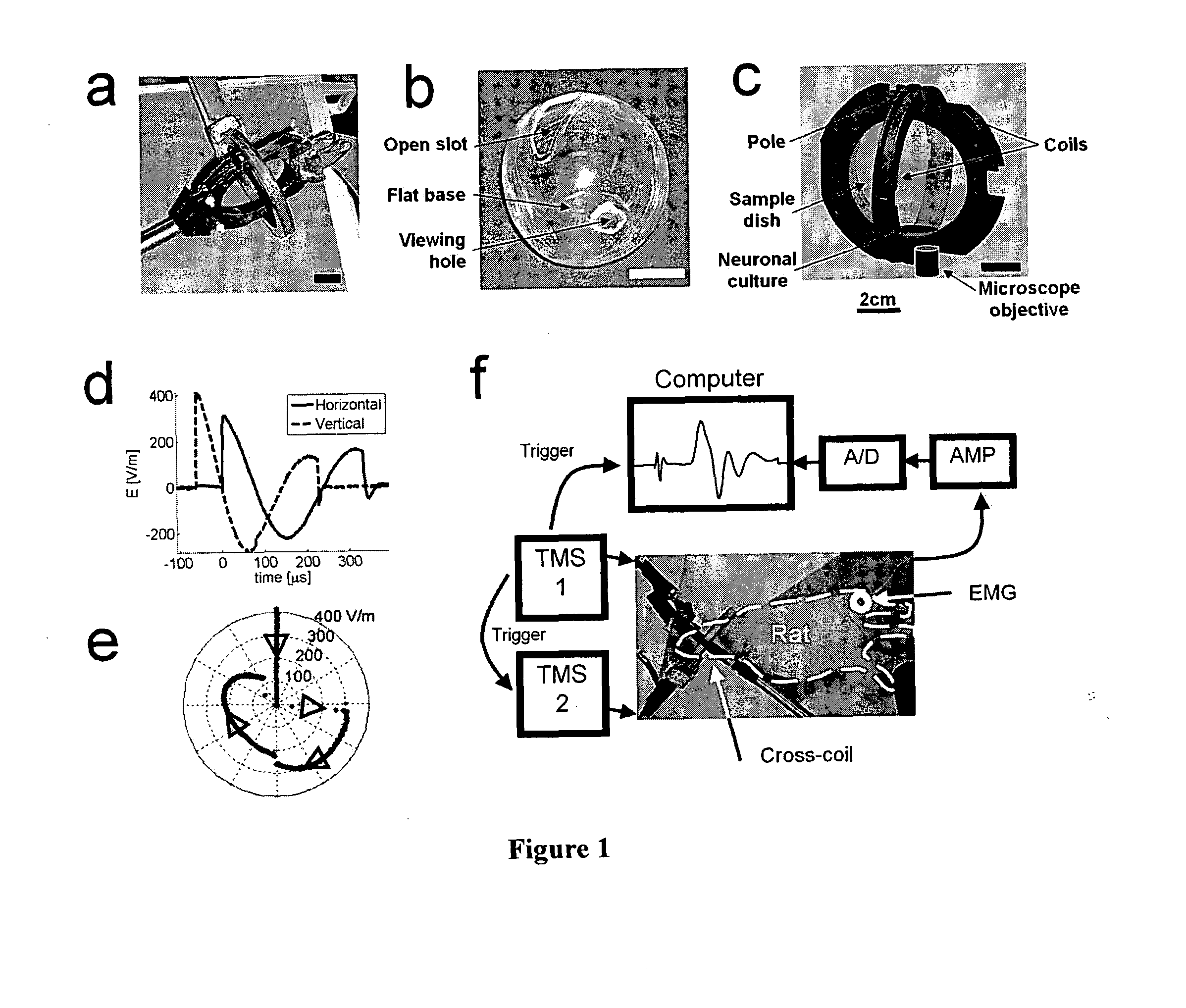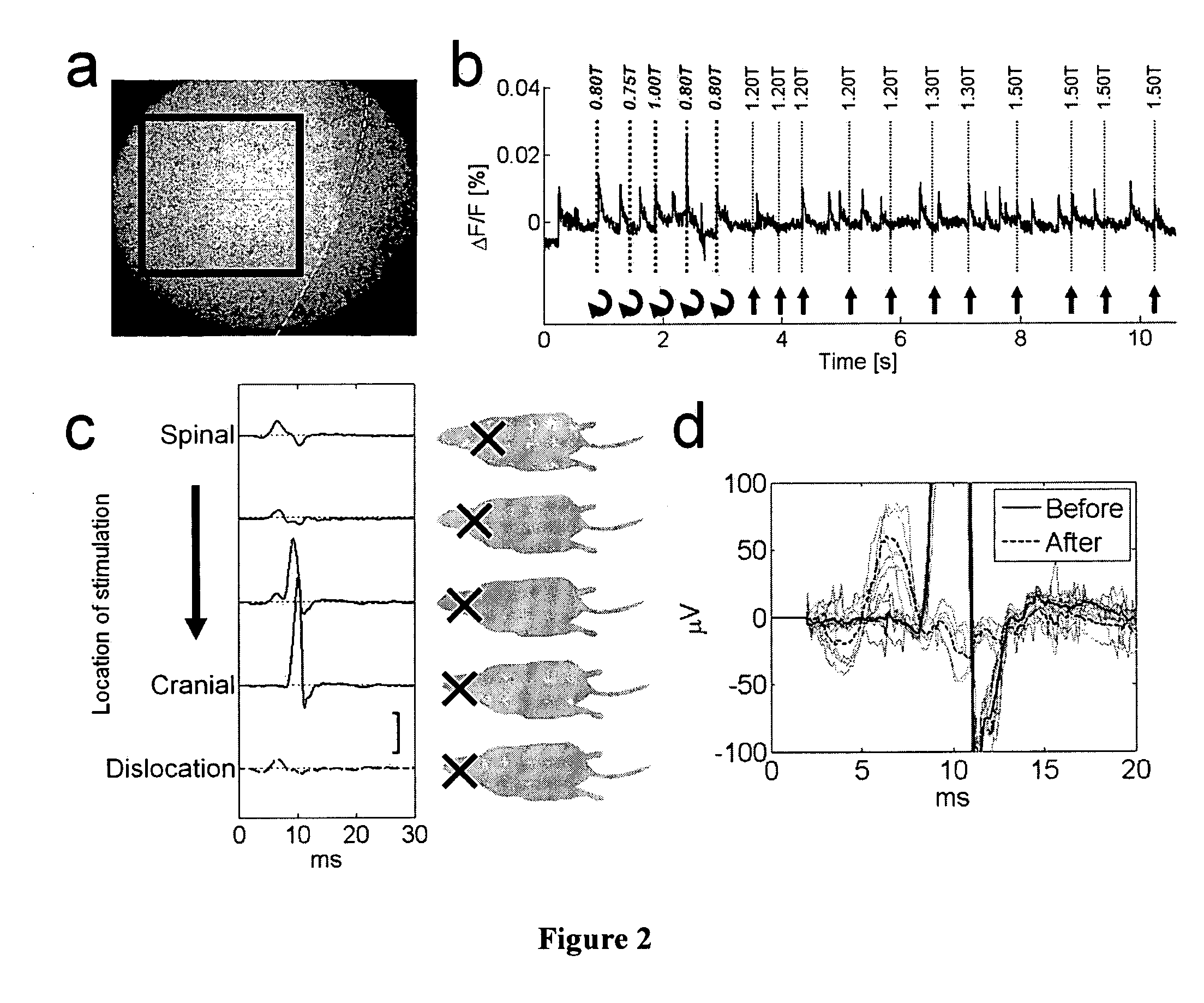Magnetic configuration and timing scheme for transcranial magnetic stimulation
a transcranial magnetic stimulation and magnetic configuration technology, applied in the field of transcranial magnetic stimulation, can solve the problems of insufficient population response driving input into neurons in the network, the precision and specificity of the activation region of the tms, and the inability to initiate the population response. the effect of neuron excitation
- Summary
- Abstract
- Description
- Claims
- Application Information
AI Technical Summary
Benefits of technology
Problems solved by technology
Method used
Image
Examples
example 1
Magnetic Stimulators for Rotating Fields
[0204]A rotating electric field was induced by using two independent sets of coils whose magnetic fields are perpendicular to each other and whose currents are phase shifted one from the other by a quarter of a cycle. Introducing a 90° phase lag between the two magnetic sinusoidal pulses, was achieved by precise triggering of two independent power supplies, each controlling a separate figure eight coil.
[0205]Power supplies. The two power supplies used were a Magstim Rapid TMS (Magstim, UK) and a home made stimulator (HMS). The HMS is based on a large 0.1 mF capacitor (Maxwell Laboratories, USA) with maximum voltage load of 22 kV and is able to obtain magnetic fields that are five times stronger than the field supplied at the sample by the commercially available Magstim Rapid. In order to achieve accurate phase lag between the two magnetic pulses, the two power supplies were synchronized using a signal generator (Keithley 3390 50 MHz Arbitrary ...
example 2
Electric Vs. Magnetic Excitation of Neuronal Cultures
[0241]According to this aspect and in one embodiment, electric stimulation is tested for insight into magnetic stimulation. Because long pulses (˜1 ms) are easy to excite electrically but not magnetically, and since the fundamental mechanisms behind the two modes of simulation are similar, the response of cultures to varying duration of electric pulses was investigated. Based on this, reasonable conclusions and conjectures were made on the mechanism underlying magnetic stimulation.
[0242]To demonstrate the time dependence, cultures that can be stimulated both electrically and magnetically were tested, and compared to those that can be excited only electrically. It naturally turns out that cultures that respond to the magnet respond to short electric pulses. What is not obvious is that cultures that do not respond to magnetic stimulation also do not respond to short pulses, and can be excited only with long electric pulses.
Methods:
E...
example 3
Magnetic Stimulator for Dendritic Excitation
[0260]In one embodiment, dendritic excitation requires magnetic pulses with a rise time of 1 ms, made possible by increasing the capacitance of the stimulator. For this a larger stimulator was constructed with a capacitor C of 4.8 mF and a maximum voltage load of 6.5 kV (3650CMF3480, General Atomics Electronic Systems, USA) capable of delivering about 10 T with a rise time of 1 ms. Two ignitrons, I1 and I2 (NL7703, National Electronics, USA) were used: I1 was used to initiate discharge through the coil and I2 was used to shortcut the coil and stop the discharge through the coil (FIG. 7). In this way, the initiation of a pulse can be controlled with I1 and the termination of a pulse can be controlled by I2.
In one embodiment, capacitors that are used in stimulators of the invention can be commercially available capacitors such as the General Atomics capacitors described in http: / / www.ga-esi.com / EP / capacitors / series-cmf-self-healing-capacitor...
PUM
| Property | Measurement | Unit |
|---|---|---|
| degree angle | aaaaa | aaaaa |
| capacitance | aaaaa | aaaaa |
| angle | aaaaa | aaaaa |
Abstract
Description
Claims
Application Information
 Login to View More
Login to View More - R&D
- Intellectual Property
- Life Sciences
- Materials
- Tech Scout
- Unparalleled Data Quality
- Higher Quality Content
- 60% Fewer Hallucinations
Browse by: Latest US Patents, China's latest patents, Technical Efficacy Thesaurus, Application Domain, Technology Topic, Popular Technical Reports.
© 2025 PatSnap. All rights reserved.Legal|Privacy policy|Modern Slavery Act Transparency Statement|Sitemap|About US| Contact US: help@patsnap.com



